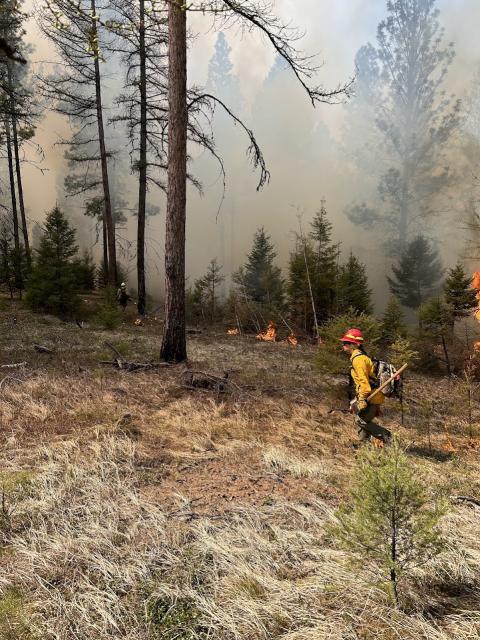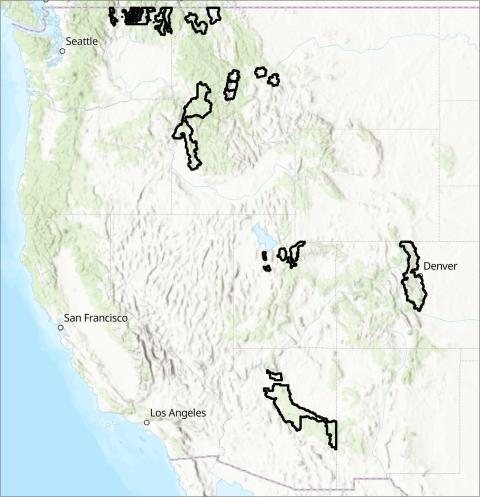A major goal of forest restoration and fuels management is reducing risk of high-severity fire and building resilience, yet currently there is high uncertainty about when and where prescribed fire can be used to successfully reduce forest density and ladder fuels via killing unwanted trees that cause high fire hazard while simultaneously maintaining large trees. This project will develop products to increase confidence that prescribed burning can be used to achieve mortality-related objectives under varying drought conditions and aid in planning maintenance burning scheduling. Improved understanding of fire-caused small tree mortality will also inform management targeted at increasing resilience to future wildfire through expanded use of prescribed fire in young natural or planted stands.
Prescribed fire, alone or in conjunction with thinning, is an important tool for both initial entry and maintenance of treatments intended to reduce risk of high-severity fire and restore forests dependent on fire. Managers use prescribed fire to achieve a number of objectives. However, tree mortality-related concerns can be a major barrier to prescribed burning implementation. Managers need accurate decision support systems to address such questions as:
- Can burning alone kill enough small-diameter trees?
- How many years does it take before trees reach fire-resistant sizes after planting and natural regeneration?
- Will too much mortality occur if burning happens during seasons of active tree growth versus dormancy?
- How will drought influence likelihood of tree death?
- Can mechanical treatments prior to prescribed fire improve survival of small trees?
Our project will address each of these questions to foster the use of prescribed fire by reducing uncertainty about small tree fire resistance and the influence of both burn season and drought on fire-caused tree mortality.
Products will provide manager guidance to increase confidence that prescribed burning can be used to achieve mortality-related objectives under varying drought conditions and aid in planning maintenance burning scheduling. Improved understanding of fire-caused small tree mortality will also inform management targeted at increasing resilience to future wildfire through expanded use of prescribed fire in young natural or planted stands. At the completion of model development and testing, we will incorporate new models that exceed current baseline accuracies into FOFEM and BehavePlus to account for season of burn and drought stress, update the Fire and Tree Mortality (FTM) database, and develop manager-oriented guidelines for prescribed burning in young stands and areas with small trees, across a range of western US forest landscapes.
Project objectives include:
- Investigate how climate influences post-fire mortality in small trees
- Develop fire resistance guidelines for small trees
- Investigate how fire resistance changes with phenology to influence post-fire tree mortality
- Develop predictive mortality models that incorporate drought and season of burn in fire effects decision support systems.
Objective 1: The FTM database contains data of tree mortality/survival and injury from fire for over 14,000 trees <8 in DBH, with 5,666 trees <4 in, for ponderosa pine, Douglas-fir, white fir, and incense cedar. The current database spans 1981-2016, which allows examination of how climate influences fire-caused tree mortality. This dataset will be combined with recently collected data from collaborators to conduct an analysis of mortality in smaller size trees and assess how mortality varies with size, crown scorch, and drought conditions.
Objective 2: To understand how long it will take trees of different species to reach fire resistant sizes, we will draw on existing team member data that includes age, bark thickness, and size for >2,000 western larch, Douglas-fir, and ponderosa pine seedlings and saplings. We will collect size, bark thickness and age data from additional species of interest by leveraging recent harvested sites. We will develop bark thickness-age and bark thickness-size relationships to model bark thickness as a function of species, age, and diameter to develop guidance about what size and age trees of different species are likely to die due to fire-caused basal injury.
Objective 3: We will examine whether mortality differs as a function of phenology (or season of burn) after accounting for fire intensity. We will collect field data following prescribed burns during different seasons and with natural and activity fuels in six WCS landscapes (4FRI, Colville Northeast Washington Vision, Colorado Front Range, Kootenai Complex, Southwest Idaho, and Wasatch) and high risk firesheds. We will focus on trees ≤ 25 cm groundline diameter (GLD) and choose 1-2 sites/burn season/WCS landscape. After each prescribed burn, we will tag trees and assess fire-caused injury and other variables that may influence mortality. Plots will be remeasured at the end of each growing season for at least two growing seasons post-fire to reassess competition and status of tagged trees.
Objective 4: Models that improve predictive accuracy of those currently in FOFEM will be added to FOFEM. Current practice is that updates to tree mortality predictions in BehavePlus and FFE-FVS always follow FOFEM. We will also develop management guides that describe how sensitivity to fires may differ by phenology and with drought stress.

